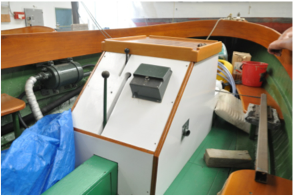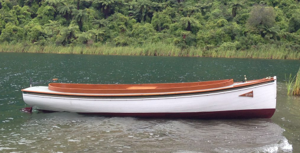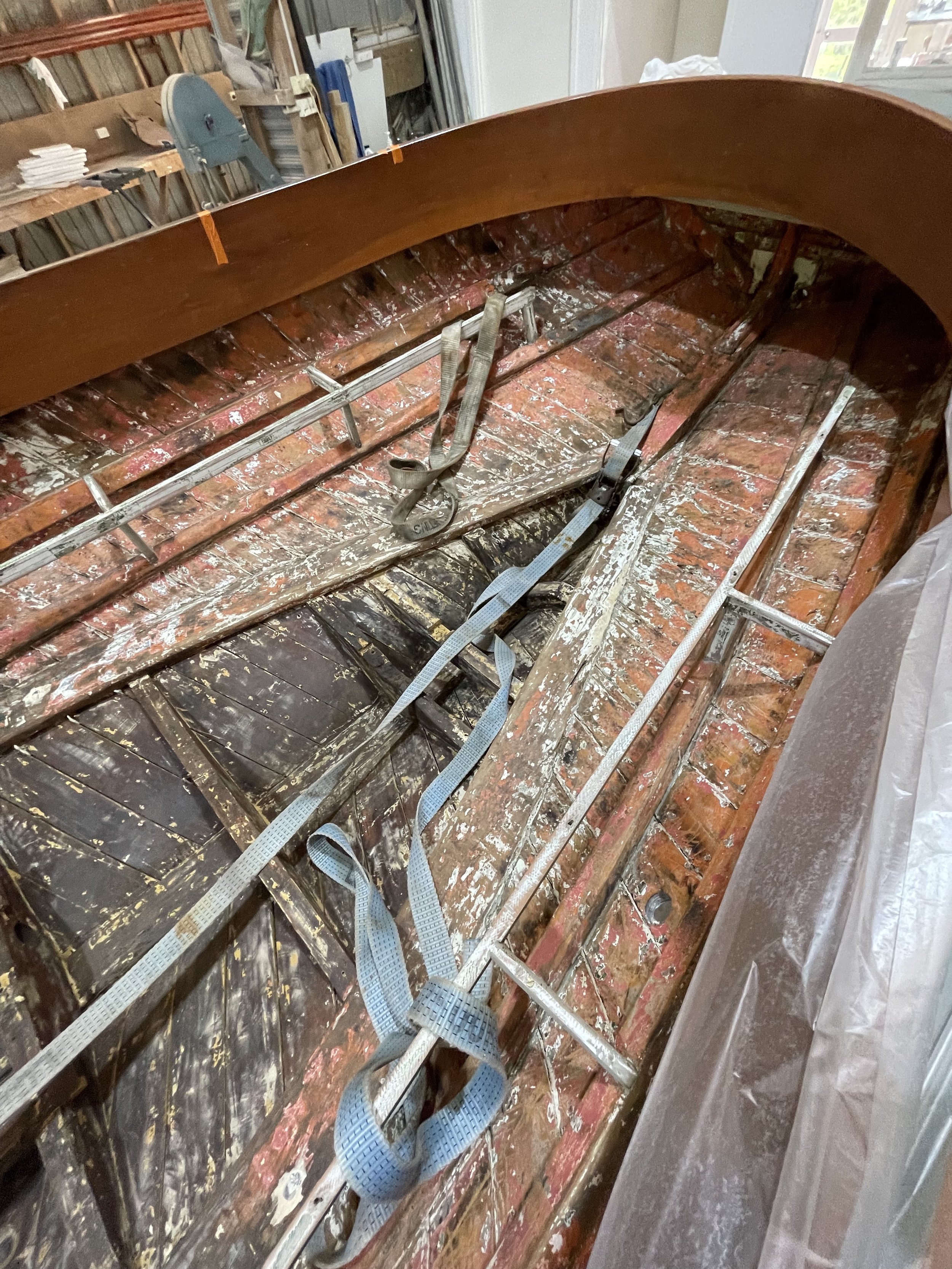Otira
Designer: Logan Bros
Built: 1902, Logan Bros, Auckland
Length Overall: 20ft (6.09m)
Beam: 8ft (2.43 m)
Draught: 2ft 5” (0.73m)
Length Water Line: 19ft (5.79m)
Construction Hull: Kauri 2 skin
Engine: Inboard Lombardini 502 20hp
Otira was generously donated to the Trust by Paul Pritchett in 2012
Otira on her launch day Auckland1902.

















Transcript of restoration of Otira 1902 Logan oil launch, 2005 - 2007 by Paul Pritchett.
“Otira” was into a shed and out of the water for the first time in her life, apart from short re-fits. After cutting off the cabin and dodger and removing the engine, the first job was to build a frame so “Otira” could be rolled over easily. A thorough clean inside to remove sand, mud and oil. The hull was refastened with copper nails and roves, particularly in the area of the cockpit sole.
Repainted inside and then rolled upside down with the burn off of the old paint, cutting off out the caulking and the replacing damaged or rotten timber with recycled kauri.
The deadwood, outer keel and stem were replaced with hardwood, as the jarrah and pohutukawa had worn over the years from mooring chains and constantly sitting on the bottom between tides. After priming the seams, a Simpsons compound was used to replace the old cotton and white lead caulking.
The hull was placed on a trolley and the engine re-installed. Coamings were steam bent and fitted after a canvas application to the deck. Rubbing strakes and new seats were installed.
“Otira’s” Engine – Stuart Diesel marine Engine H2MP No. 111
After cutting off the cabin and dodger and removing the engine, the first job was to build a frame so "Otira" could be rolled over easily. In the restored boat, the complete hull and forward deck beams, fuel tank, brass fair leads and forward bollard and rudder are all original.
One of the 403 built in the UK in the 1950’s. These 2 stroke diesels were hand built and only 8 were imported into NZ by Palmers of Auckland. This model was probably not a great success as it appears that engine 111 is one of only 2 still running in the world. The other is in the UK having been recently rebuilt from parts of 3 engines and has been recorded in “Stationery Engine” Magazine Jan, Feb and March 2008
The research that has been done on engine websites pretty well confirms these are the only two, although there will be others in various states of disrepair.
Engine 111 was rebuilt in 2007 by Stan Wilson of Lyttleton, using parts of engine 283, which he had salvaged from a yacht some years ago and not been able to make run as some parts were missing. Stan had worked on these and many other Stuart Turner engines in England and had a good knowledge of them. Many of the parts, bearings, etc are from cars and small trucks of that era – Morris 1100’s and Bedford etc.
This engine started its time in NZ as an auxiliary on “Tainui”, a 36ft keel boat, but weighs over 500lb, it was considered too heavy for a racing yacht. It has been in ‘Otira’ since the early 1960’s.
Otira was donated to the Tino Rawa Trust in 2012.
In 2023 Otira was fully restored with significant restoration work on her hull, topsides and interior.
Boating New Zealand article by Harold Kidd
The Logan Bros yard on Auckland's Mechanics Bay launched a two- skin diagonal-built 20ft (6.1m) 'oil launch called Otira in late December 1902.
She was built for "a Mr. Matthews of Lyttelton". Otira was one of the first small oil launches in the South Island. The first was probably the Logan Bros Sprite, built for Moresby of Thames in 1897. When G.J.Black of Akaroa had her shipped south in February 1899, Sprite would prove the utility of such little craft in the Canterbury coastal setting and also establish the reputation of Logan Bros as launch builders in the region.
Like Sprite, Otira was fitted with a Union engine built by the Union Gas Engine Co of San Francisco and at the time was considered the standard of the marine engine industry: well-built, well- finished in glossy black with gold trim, with reliable characteristics.
Not much is known of Otira's early history except that she spent her time at Redcliff and was one of the first launches involved in the Christchurch Sailing Club. It changed its name to become the Christchurch Sailing and Power Boat Club in early 1907, proof of how highly regarded the future of launches were on the estuary.
There is a series of images that trace Otira's time as an open launch of the type that was popular for a while on New Zealand's estuaries, rivers and lakes for picnicking and sight-seeing. These were usually little more than a big open dinghy with a simple engine. But like most early launches, Otira was modified to provide more shelter for the occupants and safer handling in rough water.
Living on the Estuary, Otira had to negotiate the often dangerous Sumner Bar to get out into open water to go down the coast to Lyttelton, Port Levy and Pigeon Bay, up the coast to Kaiapoi, over the bar at the mouth of the Waimakariri River.
In the 1920’s Otira was based at Kaiapoi, initially as a pleasure boat, but sometimes as a pilot boat for the small port. She grew a square cuddy over the engine and the front part ofthe cockpit, and later she gained a pretty, well-designed vertical tongue-and-groove D-front cabin top and a dodger.
It was in this configuration that James 'Jim' Percy Drewitt bought her and shifted her to moorings at Charteris Bay on Lyttelton Harbour. He made minor changes to the dodger over the years.
After Jim's death in 1948, his son Maurice took over, pensioning off the original Union and replacing it with a Morris Vedette petrol engine, basically a marinised side-valve Morris 8 car engine.
When Colin Manson bought Otira around 1960, the cabin top had become tired and he replaced it with a simple square-fronted unit with a raked dodger and exchanged the Vedette for a Stuart H2MR two-cylinder two-stroke diesel, engine number 111.
A later owner was David James who sold the launch to Paul Pritchett of Charteris Bay in 2002. Paul is a highly experienced yachtsman and a key member of the Charteris Bay Yacht Club. Paul kept Otira on her moorings at Church Bay for three years, and then decided to restore her to her original configuration in 2005. The rebuild was thorough. Paul stripped Otira back to her original timbers, and in the process revealed her Logan Bros builder's plate on the aft coaming which had been covered over for many years.
Once Otira was restored and in the water, Paul decided that she should go to a good home where she would be seen and used by as many people as possible. He decided to donate Otira together with her substantial custom-made road trailer, to the Tino Rawa Trust run by Tony Stevenson in Auckland. This gesture has brought Otira back to her birthplace in Auckland and guaranteed her another 100 or so years of bringing pleasure to the increasing number of Kiwis intrigued by our maritime heritage.

